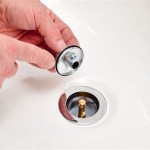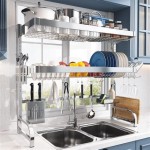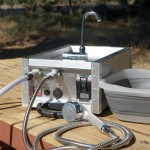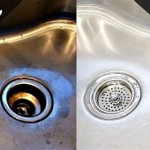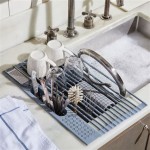Top Mount Apron Front Sinks: A Comprehensive Guide
The kitchen sink is a central element of any kitchen, serving as a focal point and a highly functional area. Selecting the right sink involves careful consideration of various factors, including material, size, style, and mounting configuration. Among the different sink styles available, the top mount apron front sink, also known as an overmount farmhouse sink, has gained considerable popularity for its unique aesthetic appeal and practical benefits. This article provides a comprehensive guide to top mount apron front sinks, exploring their characteristics, advantages, disadvantages, installation considerations, and popular materials. This guide aims to provide potential buyers with the information necessary to determine if a top mount apron front sink is suitable for their kitchen.
Understanding Top Mount Apron Front Sink Construction
Top mount apron front sinks are characterized by their exposed front, or "apron," which extends beyond the cabinetry. Unlike traditional apron front sinks that are typically undermounted, top mount versions feature a rim or lip that rests directly on the countertop. This design offers a distinct visual element, blending the farmhouse style with the easier installation process of a traditional top mount sink. The apron front, usually featuring a decorative design or a plain, smooth surface, becomes a prominent feature in the kitchen, adding character and charm. The construction of these sinks involves shaping the chosen material (stainless steel, fireclay, copper, etc.) into the desired form, followed by finishing processes such as glazing, coating, or polishing to enhance durability and aesthetics.
The exposed front, usually around 9-10 inches high, provides functional benefits. The sink basin is closer to the user, reducing strain for those who are shorter or have back pain. The large basin size accommodates large pots and pans, which can make cleaning easier and more efficient. The overmount design is the primary factor when choosing a top mount sink. It is easier to install than most other types of sinks because it sits on top of the countertop. It can work with existing cabinets since there is no need to alter them. This makes it an ideal choice for remodeling projects.
The sink's interior dimensions, depth, and overall shape are just as important as the aesthetic appeal. The depth of the basin determines its capacity, while the shape influences water drainage and ease of cleaning. A well-designed top mount apron front sink will balance visual appeal with functional considerations to create a durable and practical addition to the kitchen.
Advantages of Choosing a Top Mount Apron Front Sink
Top mount apron front sinks offer a number of advantages that contribute to their popularity among homeowners and designers.
Easier Installation: The primary advantage over undermount apron front sinks is the simplified installation process. The overmount design eliminates the need for precise countertop cutouts and complex support structures required for undermount sinks. The sink simply rests on the countertop, secured with clips and sealant, making it a more accessible option for DIY enthusiasts and reducing professional installation costs. This is especially beneficial when retrofitting existing kitchens, as it minimizes the need for extensive cabinet modifications.
Cost-Effectiveness: Due to the less demanding installation process, top mount apron front sinks can be a more cost-effective option overall. The reduced labor costs associated with installation can make them a more budget-friendly choice compared to undermount alternatives. Furthermore, the ability to work with existing countertops and cabinets can further reduce remodeling expenses.
Protection for Cabinetry: The apron front design provides a degree of protection to the cabinetry beneath the sink. The extended front acts as a barrier against splashes and spills, preventing water damage and prolonging the life of the cabinets. This is especially important for wood cabinets, which are susceptible to warping and rotting when exposed to moisture. This type of protection is also ideal for homes with children and/or pets.
Aesthetic Appeal: These sinks offer a unique blend of traditional and modern aesthetics. The exposed apron front adds a touch of farmhouse charm, while the top mount configuration provides a cleaner, more streamlined look compared to traditional undermount farmhouse sinks. This versatility allows them to integrate seamlessly into a variety of kitchen styles, from rustic to contemporary.
Disadvantages and Considerations
Despite the advantages, there are also some potential drawbacks to consider when choosing a top mount apron front sink.
Rim Visibility: The visible rim of the sink, which rests on the countertop, may not appeal to everyone. Some people prefer the seamless, integrated look of an undermount sink, where the countertop flows directly into the basin. The rim can also create a small lip that traps crumbs and debris, requiring regular cleaning.
Limited Countertop Space: The width of the sink, including the apron front and the overhanging rim, can reduce usable countertop space. This can be a concern in smaller kitchens where every inch of counter space is valuable. Careful measurements and planning are essential to ensure that the sink fits comfortably within the available space without compromising functionality.
Potential for Leaks: While the installation is relatively straightforward, improper sealing between the rim of the sink and the countertop can lead to leaks. It is crucial to use a high-quality sealant and ensure a tight, even seal to prevent water from seeping underneath the sink. Regular inspection and maintenance of the sealant are also necessary to maintain a watertight seal.
Material Vulnerability: The apron front, being exposed, is vulnerable to scratches, dents, and stains, depending on the material. Fireclay sinks, while durable, can chip if subjected to heavy impacts. Stainless steel sinks can scratch easily, and copper sinks can develop a patina over time. Choosing a durable, stain-resistant material is important to maintain the sink's appearance over the long term.
Common Materials Used in Top Mount Apron Front Sinks
The material used in the construction of a top mount apron front sink significantly impacts its durability, aesthetics, and maintenance requirements. This section explores some of the most common materials used in these sinks.
Stainless Steel: Stainless steel is a popular choice for its durability, stain resistance, and affordability. It is also resistant to heat and corrosion, making it a practical option for busy kitchens. Stainless steel sinks are available in a variety of gauges (thickness), with lower gauges indicating thicker steel. Thicker gauges are generally more durable and less prone to denting. The finish can range from polished to brushed, each offering a different aesthetic appeal. The material is generally easy to clean and maintain, but it can be prone to water spots and scratches.
Fireclay: Fireclay sinks are made from a combination of clay and minerals that are fired at extremely high temperatures. This process creates a dense, non-porous material that is highly resistant to scratches, stains, and heat. Fireclay sinks are known for their durability and classic farmhouse look. However, they are also more expensive than stainless steel sinks and can be prone to chipping if subjected to heavy impacts. These sinks are typically very heavy, so proper support is essential during installation.
Copper: Copper sinks offer a unique aesthetic appeal with their warm, reddish-brown tones. Copper is naturally antimicrobial, making it a hygienic choice for the kitchen. Copper sinks develop a patina over time, which is a natural darkening and color variation of the metal. Some people appreciate the patina for its rustic charm, while others prefer to maintain a consistent finish. Copper sinks require special cleaning products to prevent corrosion and maintain their appearance.
Cast Iron: Cast iron sinks are durable and offer excellent heat retention. They are typically coated with a porcelain enamel finish, which provides a smooth, glossy surface. Cast iron sinks are available in a variety of colors, allowing for customization to match the kitchen décor. However, they are also very heavy and require sturdy support during installation. The porcelain enamel finish can be prone to chipping and scratching if not properly cared for.
Installation Considerations for Top Mount Apron Front Sinks
While the installation of a top mount apron front sink is generally easier than that of an undermount version, there are still several important considerations to keep in mind.
Countertop Cutout: Accurate measurements are crucial for creating the countertop cutout. The sink manufacturer typically provides a template or detailed instructions for the cutout dimensions. It is important to follow these instructions precisely to ensure a proper fit. Before cutting, double-check all measurements against the sink itself, not just the template, as variations can occur.
Cabinet Support: Ensure that the cabinets beneath the sink are sturdy and capable of supporting the weight of the sink, especially if choosing a heavy material like fireclay or cast iron. Additional support may be required in the form of reinforced framing or a sink base cabinet specifically designed for apron front sinks. Consulting with a professional contractor or cabinet maker is advisable to ensure adequate support.
Sealing: Proper sealing between the rim of the sink and the countertop is essential to prevent leaks. Apply a generous bead of high-quality silicone caulk around the perimeter of the cutout before setting the sink in place. After the sink is installed, remove any excess caulk with a damp cloth or sponge. Allow the caulk to cure completely according to the manufacturer's instructions before using the sink. Regularly inspect the sealant for cracks or damage and reapply as needed.
Plumbing Connections: Ensure that the drain and water supply lines are properly aligned and connected. Use new plumbing fittings and connections to prevent leaks. Check for any leaks after the installation is complete by running water into the sink and inspecting the connections underneath. Address any leaks immediately to prevent water damage.
Faucet Selection: Choosing a faucet that complements the style and size of the sink is important. Consider the reach and height of the faucet spout to ensure that it can easily reach all areas of the sink basin. A pull-down or pull-out faucet can be particularly useful for cleaning larger pots and pans. The finish of the faucet should also coordinate with the sink and other kitchen hardware.

Cmi Brimley Retrofit Dual Mount Stainless Steel 33 In 1 Hole Single Bowl Curved Farmhouse Apron Front Kitchen Sink Satin

Arcticstone Gkta362119 36 Inch Solid Surface White Stone Single Bowl Top Mount Kitchen Sink With Backsplash And Strainer Matte

33 Inch Drop In Top Mount Farmhouse Apron Front Kitchen Sink Ap3324 9

Horow 36 Farmhouse Apron Sink Undermount Fireclay Kitchen

33 Retrofit Farmhouse Apron Front 16 Gauge Workstation Kitchen Sink Single Bowl In With Workflow Ledge And Accessories For Top Mount Drop Installation Pvd Gunmetal 95d9031 T33s Gs Delta Faucet

Sinkology Josephine 34 In 3 Hole Quick Fit Farmhouse Apron Front Drop Double Bowl Crisp White Fireclay Kitchen Sink Sk453 34fc The Home

30 Retrofit Farmhouse Apron Front 16 Gauge Stainless Steel Single Bowl Kitchen Sink For Undermount Drop In Installation With Accessories 95j132 T30s Ss Delta Faucet

Karran Farmhouse Apron Front 34 In X 21 25 Black Quartz Double Offset Bowl Kitchen Sink Qa 760 Bl At Com

33 Apron Front Farmhouse 16 Gauge Stainless Steel Sink Kraus

Alfi 36 Double Bowl Thick Wall Fireclay Farmhouse Apron Sink White Ab3618arch W

